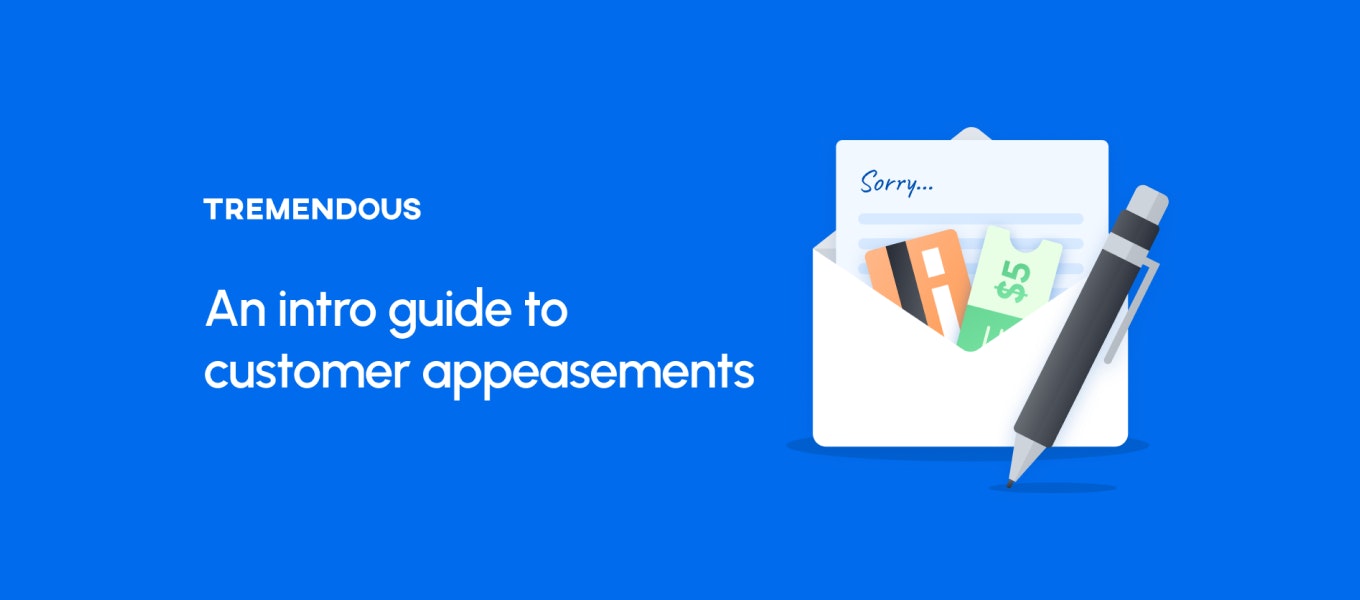Sending customer appeasements quickly is a proven recovery strategy for when things go wrong. And pairing an apology with an incentive can mean the difference between losing customers forever or re-gaining their trust.
As consumers, we’ve all been there – your flight was delayed. The wings were cold. Your hotel was overbooked so you end up sleeping in your car. (Okay, maybe we haven’t all been there).
When these things happen, we reach an emotional fever pitch. We’re angry. We’re looking for catharsis – often in the form of a disgruntled review. Or we call a couple friends and vent, swearing off the offending brand forever.
A well-timed customer appeasement can prevent backlash, and even win back customers for life. But there’s a right way and a wrong way to appease customers after an inconvenience.
An apology without any financial compensation attached doesn’t go over well. Neither does an incentive with no admittance of wrongdoing.
In this guide, we’ll tell you how to get customer appeasements right.
What does customer appeasement look like?
When a customer reports a negative experience, a brand may offer a discount, refund, or perk to correct it. Appeasements vary across industries from banking to baking, but there are several common responses to customer dissatisfaction:
Discounts for a future service
Full or partial refunds
Upgrades or perks for next time
A canned apology email
When they work, appeasements can significantly improve customer satisfaction, customer loyalty, and word-of-mouth.
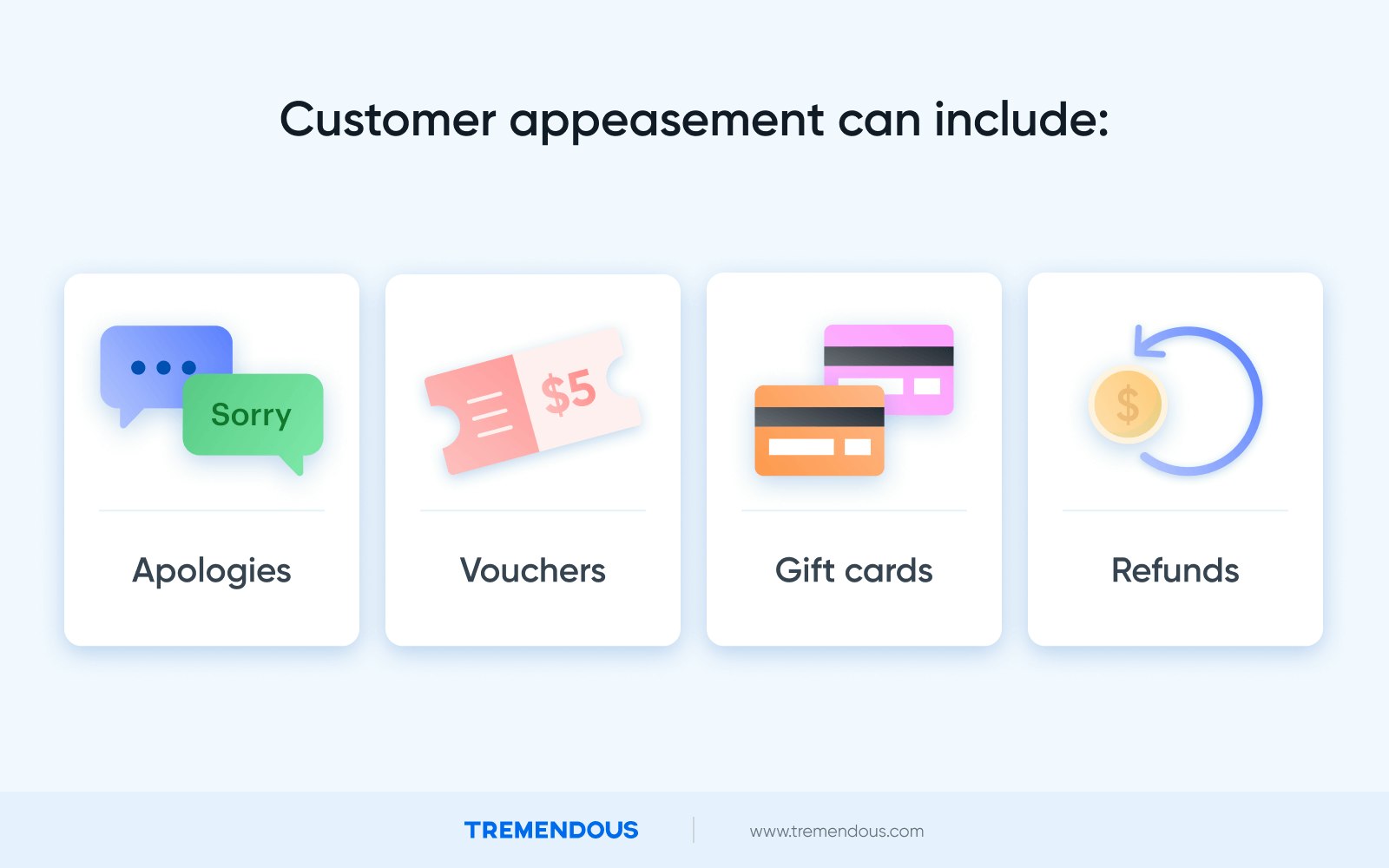
What actually works best?
The key to any great apology is authenticity. Customers don’t want to “talk” to a bot when things go wrong. Benjamin Ho’s study identifies that a simple “We’re sorry this happened and that it negatively impacted your experience” goes a long way.
That’s the first step – human sincerity.
After that, the window of time to redeem your brand is wide open. And based on the research, you should be throwing some money into that window.
Offering an unhappy customer monetary compensation in the form of a Visa gift card is more impactful than giving them a refund or loyalty points.
One study found that “monetary compensations are the only tool that can reverse the strength of negative emotions.”
Read that again - reverse negative emotions. In the heat of the moment, your customer is only thinking about how wronged they feel.
It’s your job to reroute that cognitive path in their brain that says, “This company sucks and I’m never using them again.”
Money is part of the remedy for that, but it’s not the only ingredient. Customer input is important. (Using Tremendous to appease customers is a perfect way to give them choice in how they’re refunded or paid. We give recipients 1,000 different payment options to choose from.)
Inviting customers to provide input into how they’d like to be appeased does a couple important things (Guo, Lin, et al. 2016):
It shapes a customer’s fairness perception. If customers have some say in how they’re compensated after a service failure, they’re more likely to feel they’ve been treated fairly.
It increases the likelihood that they’ll buy from you again.
Customers who are involved in the appeasement process feel more empowered, which redeems their trust in brands that may have zigged when they should’ve zagged, according to a 2017 Journal of Business Research paper.
Involving customers in the appeasement process is also called “co-creation”. Co-creation is a customer-centric approach to service creation.
There are three ways customer input can be incorporated into the appeasement process:
Solicit feedback prior to making an appeasement decision. Considering customer feedback before you deliver an incentive makes them feel heard.
Accept recommendations for how the customer should be appeased or compensated. This ensures customers get the right kind of appeasement.
Communicate with customers along the way, giving them information about the appeasement process. This ensures they know what to expect.
The big thing to keep in mind is that product or service failures throw customers into a spiral of uncertainty. They expected one thing, and they got another.
So giving customers a sense of control over the appeasement process can quell these feelings of uncertainty. And win back the trust of consumers.
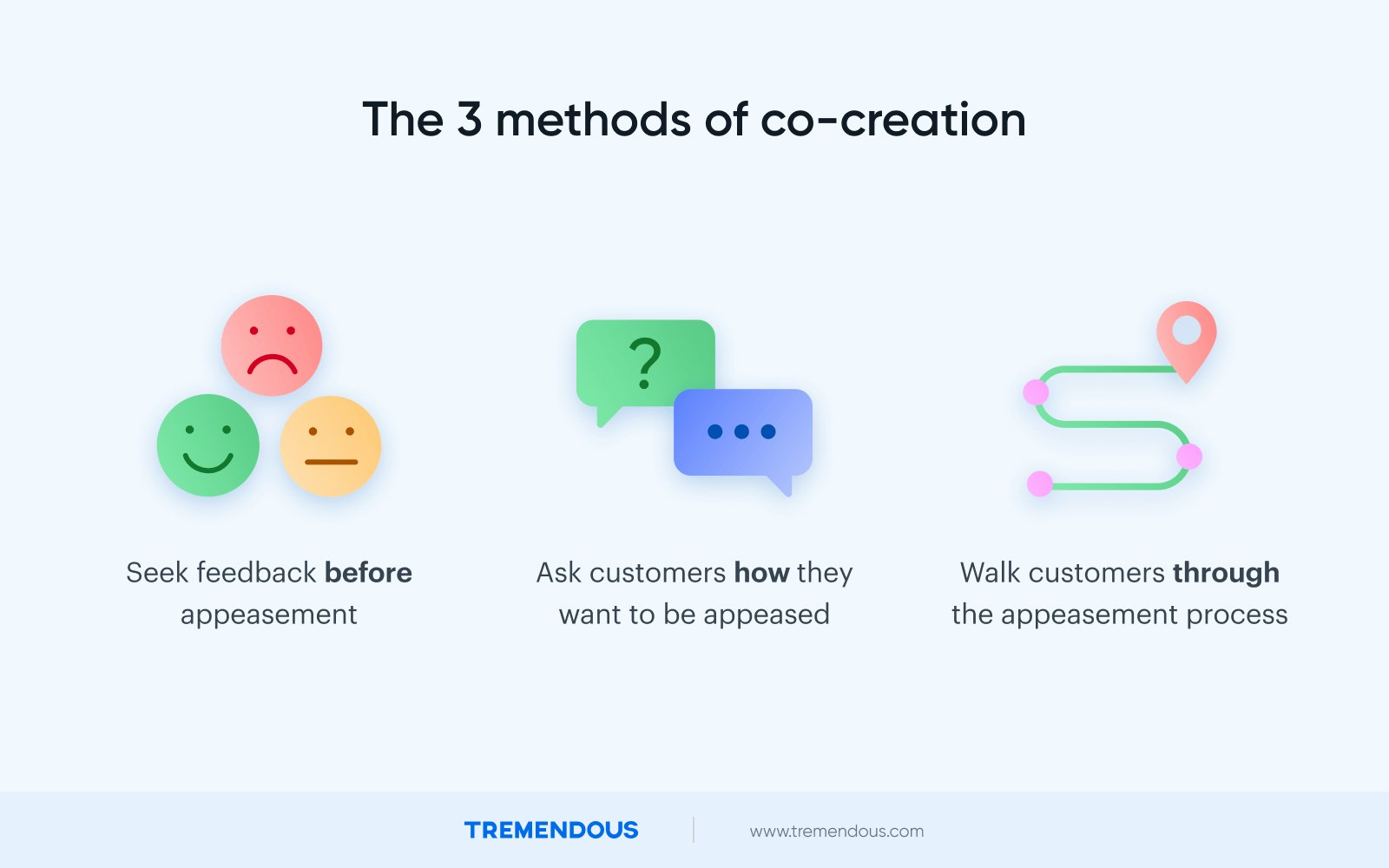
Timing matters
If you’re going to apologize to a customer and send over an incentive to soften the blow, you need to do so quickly.
But not a literal minute after the issue is reported. Apologizing too soon can signify an insincere “auto-response.”
Customers want to feel heard first, so companies should practice active listening in these scenarios. Every incident is different, and reacting too soon or too broadly could make the customer feel even less important.
From Do Not Apologize Too Early by Lidingrong Huang:
“Customers with a high interaction expectation will be more satisfied if the employee apologizes after listening to their complaints."
That being said, don’t wait around too long. Certainly respond within the hour.
A 2007 study in the Journal of Consumer Research determined that incentives are most effective when offered shortly after an incident.
Otherwise, customers have plenty of time to stew in their anger. And that leaves them more time to condemn the brand.
The more severe the service failure, the more important it is to compensate customers quickly (Roehm & Brady, 2007).
For example: a short flight delay may not be a huge deal. Sitting in the terminal for twenty minutes longer than expected generally doesn’t bother people too much.
A multi-hour flight delay, on the other hand, can completely change someone’s plans for the day. They may have to rethink their itinerary and cross some highly-anticipated activities off their list.
Naturally, the bigger the failure, the angrier a customer is inclined to become.
Immediacy is one of your best defenses against an disgruntled Yelp review or a loss of customer loyalty.
And the ROI on a quick customer appeasement is significant: Hampton Inn allows every hotel staffer to offer an immediate refund on dissatisfied guests’ stays. And they estimate that for every dollar refunded, they earn seven dollars in future revenues (Stoller, 2005).
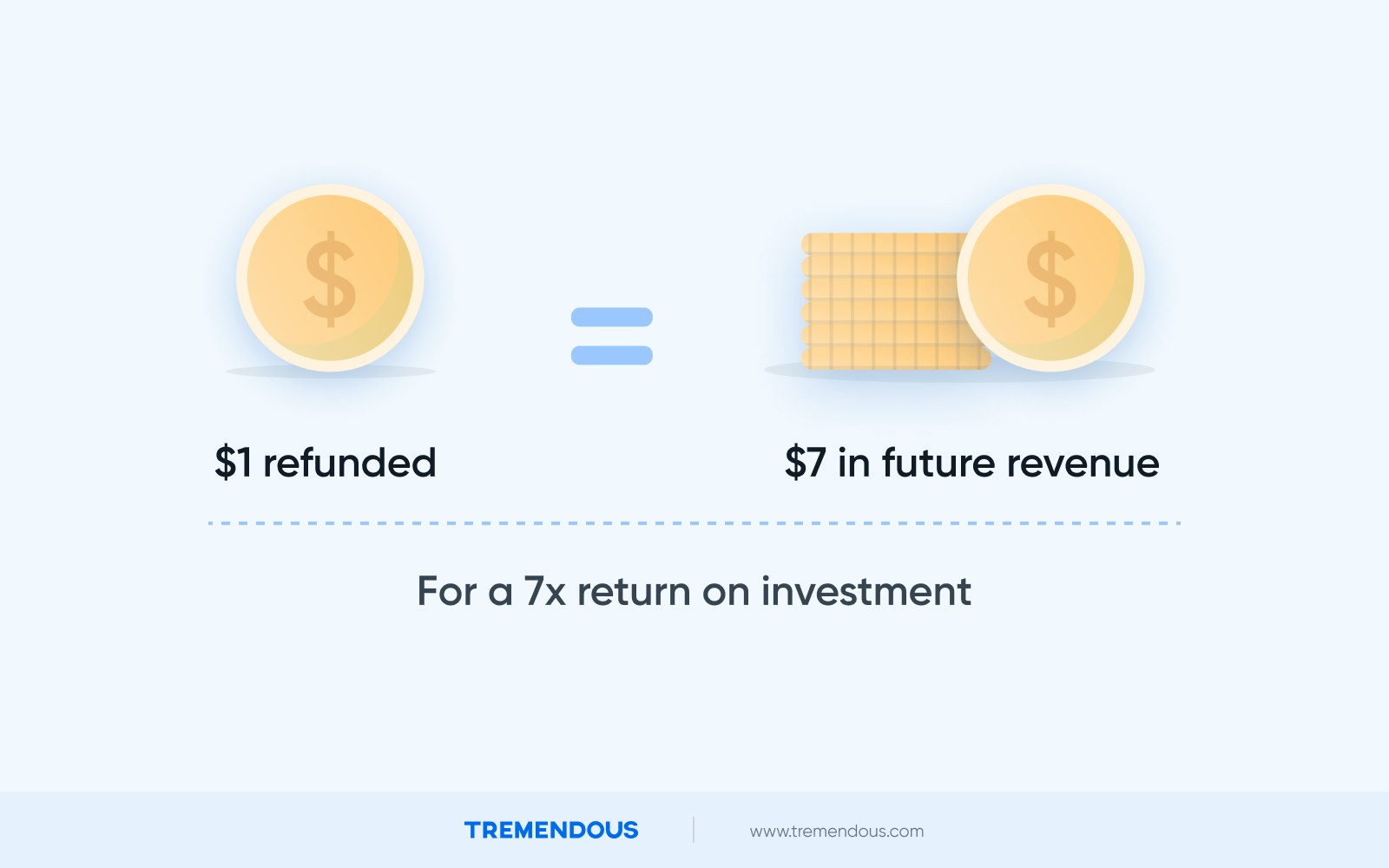
An apology with an incentive means the most
A seven-to-one revenue vs. spend ratio is a compelling case, but simply apologizing or refunding a customer won’t earn a brand that level of loyalty.
In a nationwide study of 1.5 million Uber riders, researchers found that apologizing or offering a $5 voucher free of an apology were ineffective appeasements (Halperin et al. 2019).
However, an apology and a $5 voucher were a winning method for compensating riders for a late ride.
In fact, the benefits of an apology and a voucher linger even three months after the initial bad experience. Meanwhile, any benefits that come from an apology with no accompanying incentive quickly fades.

Does customer appeasement make a difference?
Well, ask yourself this question. Can you think of a time you had a terrible experience with a company? I’m sure we all can (see above: sleeping in car).
What would take you from an Angry Tweeter to an enthusiastic brand ambassador?
Uber services 15 million rides per day, making even a small percentage of late rides a huge opportunity for potential loss.
One study from the National Bureau of Economic Research found that:
Riders who were offered a monetary incentive were more likely to use Uber again
Riders who were offered only an apology (or nothing) went on to spend 5-10% less on the platform.
So, yeah, appeasements matter.
Weirdly, an effective customer appeasement can make customers even more loyal than they were before the service failure, in some instances.
The service recovery paradox
The service recovery paradox (SRP) suggests that a customer may be even more satisfied and loyal to a brand after a service failure. But only if the company apologizes and sends a monetary incentive shortly after an incident.
A 2007 meta-analysis of 21 studies provides robust evidence that the SRP exists.
But there’s an important caveat. The SRP is more likely to occur when:
The service failure is minor
The recovery effort exceeds customer expectations
These findings are significant for industries where service failures are pretty regular.
Rather than mitigating service failures, brands would be better off investing in effective appeasement.
That way, they can win higher satisfaction from their customers than they would if they just eliminated these failures entirely.
When appeasement doesn’t work
Of course, appeasement only goes so far.
Repeated apologies for recurring service failures had adverse effects in the Uber study.
Likewise, appeasement incentives may be less effective for more significant service failures.
Take, for example, our multi-hour flight delay example. In this instance, a customer may be so distracted by the logistics of changing connecting flights and rearranging plans that they don’t even recognize the incentive.
These findings further underline the importance of prioritizing action when service failures are minor.
A slight disruption in a customer’s journey may feel insignificant. But it’s a meaningful opportunity for the brand to assert itself as the customer’s preferred vendor for life.
The benefits of customer appeasement
Issuing a simple apology and a small incentive as soon as possible can help your brand:
● Win back customer satisfaction
● Earn brand loyalty for life
● Build brand equity
● Turn inevitable service failures into business opportunities
There’s a lot to gain and a lot to lose when it comes to customer appeasement. Doing it right pays off. And doing it wrong causes real damage.
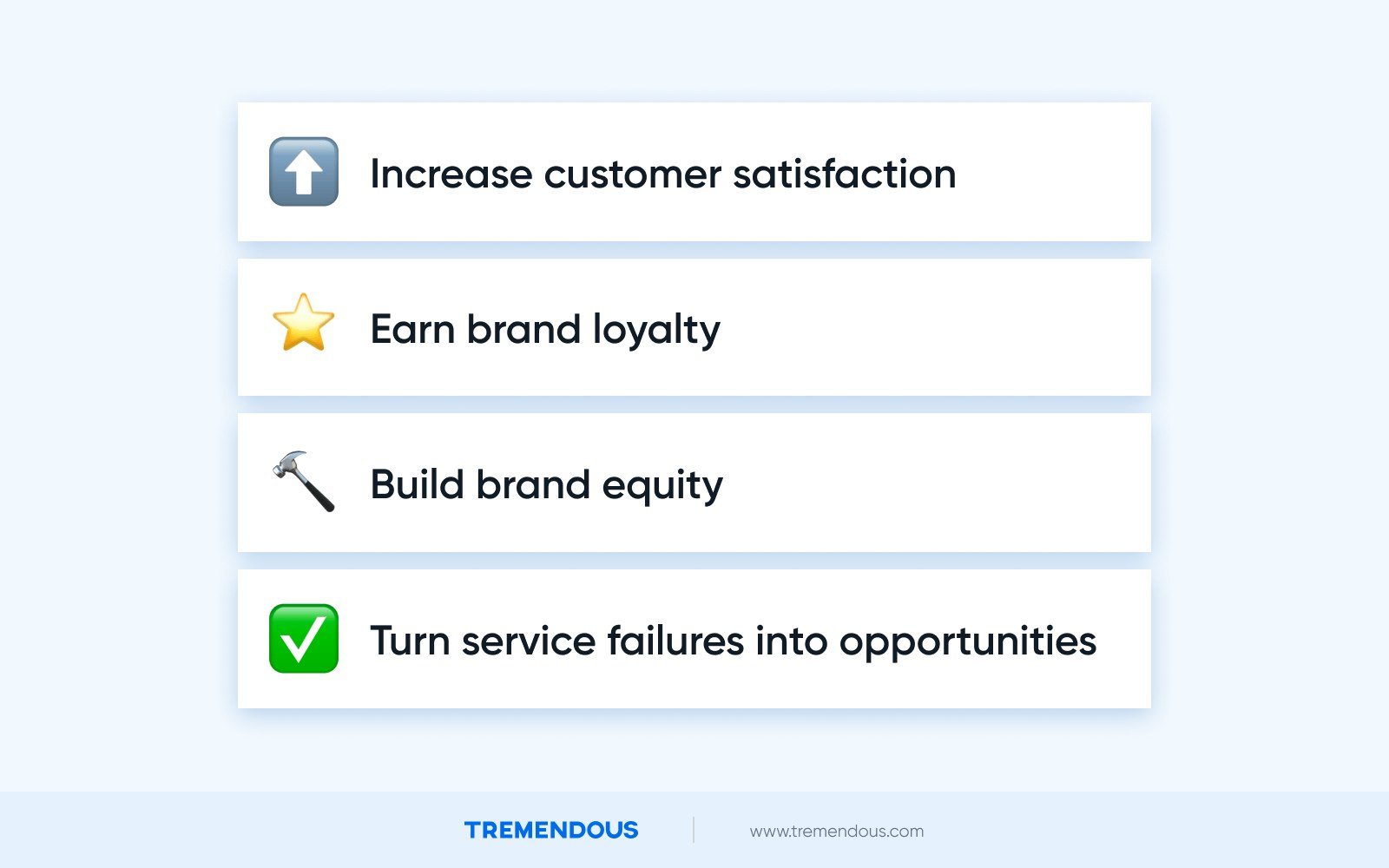
The bottom line
People have choices. And they have voices.
Even if they aren’t posting their experience on social media (and they might be), they will talk about it with friends.
Every mistake is an opportunity. The money you spend on recovery amounts to a lot less than the cost of losing a customer’s business forever.
By following these methods, companies can win back customers, keep their profits up, and take things a step further by developing their very own cheerleading squad.
